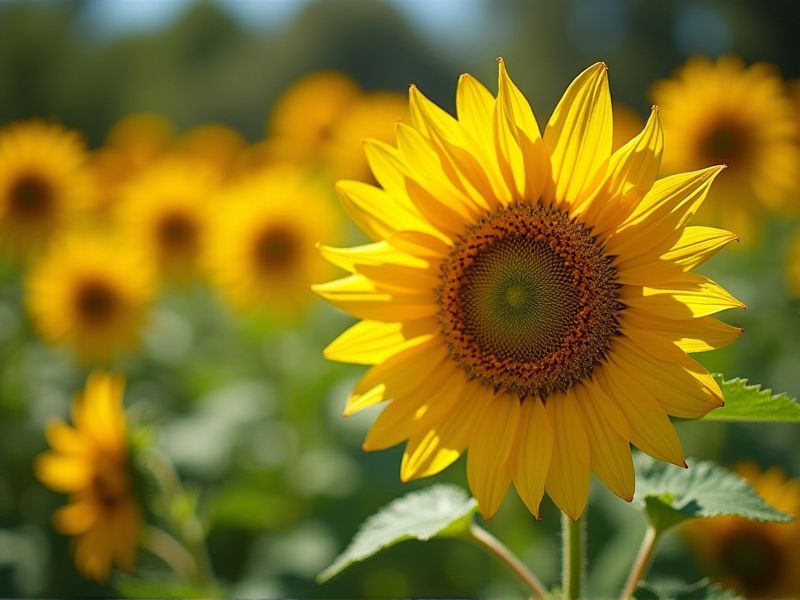
Succulents, such as Echeveria and Sedum, thrive in sunny environments while needing minimal water, making them ideal for gardeners seeking low-maintenance options. Agave, another drought-tolerant succulent, can add dramatic flair to your landscape and only requires occasional watering. Lavender, known for its fragrant flowers, not only tolerates full sun but also attracts pollinators while resisting drought. Ornamental grasses, like Blue Oat Grass, enhance aesthetic appeal with their striking texture and resilience under sunlit conditions. Choosing these plants ensures a vibrant garden that conserves water and requires less care, perfect for busy lifestyles or arid climates.
List of some Sun-loving plants that require little water
- Lavender (Lavandula)
- Agave (Agave americana)
- Oleander (Nerium oleander)
- Rock Rose (Cistus)
- Yucca (Yucca filamentosa)
- Coneflower (Echinacea)
- Sedum (Sedum spp.)
- Portulaca (Portulaca grandiflora)
- Lantana (Lantana camara)
- Russian Sage (Perovskia atriplicifolia)
Important things about Sun-loving plants that require little water
Drought-Tolerant Species
Sun-loving plants like sedum, lavender, and agave are ideal choices for water-efficient gardens. These drought-tolerant species thrive in full sunlight and display vibrant colors, making them visually appealing while conserving water. By incorporating such plants into your landscape, you can create a low-maintenance garden that withstands dry conditions. Choosing these resilient varieties not only enhances biodiversity but also supports sustainable gardening practices, helping to reduce overall water consumption.
Native Plant Options
Consider incorporating succulents like Agave or Yucca into your landscape, as these native plants thrive in full sun conditions while requiring minimal water. Other suitable options include Lavender and California Poppy, which not only add vibrant colors but also attract pollinators to your garden. Incorporating these drought-tolerant species can enhance your outdoor space's biodiversity, making it both eco-friendly and visually appealing. By choosing sun-loving native plants, you'll create a sustainable garden that adapts well to your local climate and conserves water resources.
Soil Drainage Importance
Soil drainage plays a crucial role in the health of sun-loving plants that thrive with minimal water, such as succulents and Mediterranean herbs. Proper drainage prevents waterlogging, which can lead to root rot and nutrient deficiencies, ultimately stunting growth and vitality. You can enhance soil drainage by incorporating materials like perlite or sand, allowing excess water to escape while retaining essential moisture. Choosing the right location with ample sunlight also contributes to the well-being of these drought-resistant species, promoting robust root development and vibrant foliage.
Mulching Benefits
Mulching around sun-loving plants drastically conserves soil moisture, making it an ideal practice for drought-tolerant species such as lavender and succulents. This layer of organic material, like wood chips or shredded bark, regulates soil temperature and prevents rapid evaporation, promoting healthier root systems. You can reduce weed growth, which competes for vital nutrients and water, by applying mulch effectively. Over time, the decomposing mulch enriches the soil, providing essential nutrients directly to your sun-loving plants.
Watering Schedule Adjustments
For sun-loving plants such as succulents and certain varieties of ornamental grasses, a customized watering schedule can enhance growth and health. These plants thrive with less frequent watering, typically requiring hydration every 1 to 2 weeks, depending on environmental conditions. Ensure the soil is well-draining to prevent root rot; this is crucial for the survival of drought-tolerant species. Your watering routine should take into account the temperature and humidity, adjusting the frequency during peak summer months when evaporation rates are higher.
Sun Exposure Needs
Sun-loving plants such as succulents, agaves, and native wildflowers thrive in bright sunlight while requiring minimal water. These drought-tolerant species are ideal for xeriscaping, helping conserve water while providing vibrant color and texture to your garden. If you're looking to create a low-maintenance landscape, consider incorporating plants like sedums or lavender, which not only endure heat but also attract pollinators. By selecting these resilient varieties, you can enjoy a flourishing garden that enhances biodiversity and reduces water consumption.
Light And Soil Compatibility
Sun-loving plants that thrive in well-drained soil are ideal for those looking to conserve water while enhancing their gardens. Varieties such as Sedum, Lavender, and Yarrow are not only drought-resistant but also flourish in full sunlight, making them perfect for xeriscaping. When selecting soil, ensure it has good aeration and drainage to prevent root rot; sandy or loamy mixes work best for these resilient species. To maintain your garden's aesthetic and health, consider adding organic mulch, which retains soil moisture while providing essential nutrients as it decomposes.
Growth Habits And Spacing
Sun-loving plants such as succulents and certain varieties of Mediterranean herbs thrive in well-drained soils and require ample sunlight for optimal growth. When planting, ensure to space them adequately--typically 12 to 18 inches apart--to promote airflow and minimize competition for nutrients. This spacing reduces the risk of fungal diseases while allowing each plant to access sunlight. By selecting drought-tolerant species like Lavandula (lavender) or Rosmarinus officinalis (rosemary), you can cultivate a beautiful, low-water garden that flourishes in sunny conditions.
Pest Resistance Characteristics
Sun-loving plants, such as succulents and certain varieties of ornamental grasses, exhibit remarkable pest resistance traits. These species often thrive in arid climates, reducing the likelihood of infestation by pests that thrive in moist conditions. Many sun-loving plants possess physical barriers, such as thick, waxy leaves or aromatic oils, deterring insects and other herbivores. By cultivating these resilient plants, you can create a vibrant, low-maintenance garden that flourishes with minimal water and fewer pest-related issues.
Seasonal Maintenance Requirements
Sun-loving plants such as Sedum, Echeveria, and Lavender thrive in bright conditions while requiring minimal watering, making them ideal for xeriscaping. During the growing season, ensure these plants receive at least six hours of direct sunlight daily to promote robust growth and vibrant blooms. It's essential to assess soil moisture before watering; typically, letting the soil dry out between sessions helps prevent root rot. In preparation for the changing seasons, consider applying a layer of mulch to retain soil moisture and reduce competing weeds, giving your plants the best chance to thrive.
